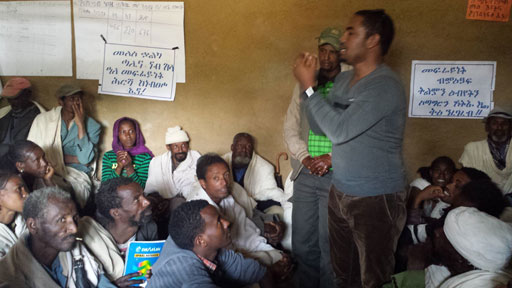6.4 Levels of community engagement
Community engagement activities can be categorised as different levels, as shown in Figure 6.3. The levels indicate increasing involvement and active participation by the community in the process.
The first level is information sharing. This is a two-way process in contrast to just providing information, which is a one-way flow of information from government (or other authority) to the community. Under information sharing, government considers information from the community as well as providing the community with information.
The second level of community engagement is consultation. This is a another two-way process in which government or service provider seeks and considers the views of citizens, clients or communities on policies, programmes or services that affect them directly or in which they may have a significant interest (Figure 6.4).

Which methods of providing information to communities have you read about in previous study sessions?
In Study Session 5, community meetings, local radio, public hearings and public announcements were mentioned. You may have also thought of posters and leaflets.
The different levels of engagement illustrated in Figure 6.3 may not all apply in all community engagement initiatives. However, as the levels of engagement extend from consultation (Level 2) through the higher levels, the amount of community participation increases and so does the level of community empowerment. Empowerment is the process whereby individuals or communities gain confidence, self-esteem and power to articulate their concerns and ensure that action is taken to address them. Each successive level enables communities to be more active and empowered participants, having a greater voice and greater influence in decision making on policies, programmes, practices or in addressing urban WASH issues. At the highest level, Level 5, the community takes over management and control of the project.
The objectives of each level of engagement are summarised in Table 6.1. Essentially each level focuses on a different type of engagement and can achieve different objectives.
| Level and type of engagement | Explanation | |
| 1 | Sharing information | Objective: To share accurate, timely, relevant and easily understood information about decisions regarding policies, WASH programmes, services or issues that have arisen. Information can be passive (poster or brochure) or active (face-to-face meetings). This level is the primary form of community engagement, on its own it offers no further involvement – but it underpins all other levels and is necessary for successive levels of engagement. Information assists the community in understanding the issues and increases their capacity to effectively contribute in successive levels of engagement. |
| 2 | Consultation | Objective: To actively seek community opinions, before a decision is made. Communities’ views helps inform the final decision. |
| 3 | Planning together | Objective: To collaborate with the community in identifying and analysing issues, developing alternatives and identifying preferred solutions, communities provide input into the planning and evaluation. May involve short-term collaboration or more permanent partnerships, and a reporting mechanism so that contributions are monitored. |
| 4 | Acting together | Objective: Similar to planning together, except that the community will be involved in implementing as well as identifying preferred solutions, i.e. the WASH practitioner and communities share in the planning and evaluation and also share responsibility for making decisions and implementing them. May involve sharing additional resources. |
| 5 | Community directed | Objective: To support or enable the community to identify issues and solutions, make decisions and implement them and hence forward to manage a service. Community may be referred to as a partner. Provides a framework with financial resources to enable communities to plan, commission, manage, deliver and evaluate their own services. Builds community capacity for planning and delivering services and addressing community issues. |
6.3 Guiding principles of community engagement

